Warmth, character, and texture come naturally when terracotta takes center stage in a bathroom. This earthy hue offers a grounded yet stylish way to introduce personality without overwhelming the space. Whether featured through tile, plaster, or patterned wallpaper, a terracotta accent wall adds visual interest and a cozy vibe that pairs beautifully with both rustic and modern decor. Its ability to complement wood, stone, and matte finishes makes it a versatile choice for anyone craving a unique but approachable design twist. This curated guide explores impactful ideas that show how terracotta can elevate your bathroom without sacrificing comfort or functionality.
Matte Terracotta Tile Drenching
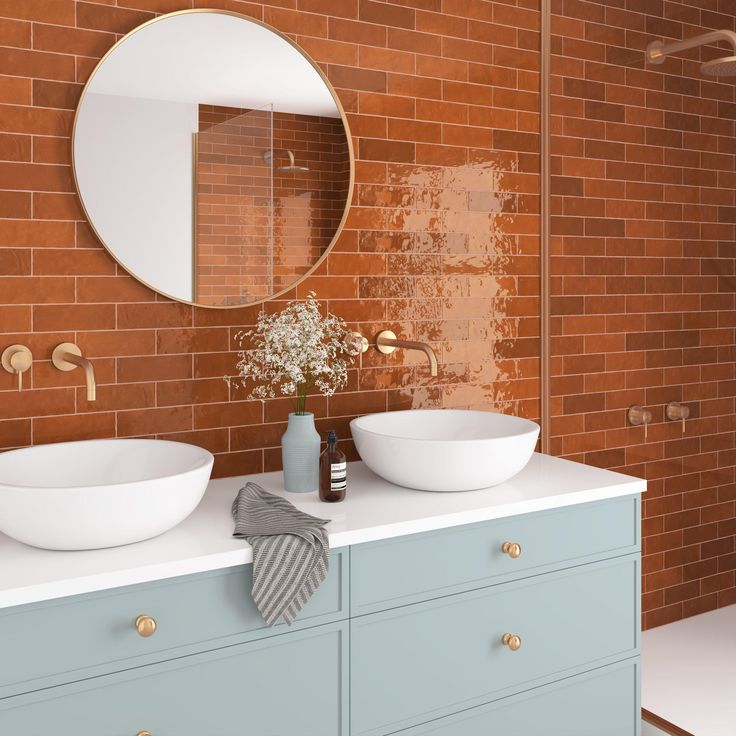
Saturated color schemes are gaining traction in bathroom design, and matte terracotta tile drenching brings warmth and depth without overwhelming the senses. Covering walls and even floors with this muted, clay-toned finish delivers a grounded aesthetic that feels both contemporary and rooted in natural elements. The matte surface softens light reflection, creating a relaxed, spa-like atmosphere. This treatment is especially effective in smaller bathrooms where continuity of tone enhances perceived space. Pairing this earthy hue with matte white or natural stone fixtures adds balance and visual rest. The look works seamlessly with minimal décor, allowing the color to speak on its own. Matte terracotta tiles also offer impressive durability and slip resistance, making them practical in wet areas. Opt for large-format tiles for a modern look, or go with smaller hexagonal pieces to introduce subtle pattern play. This design idea suits Mediterranean, bohemian, and even Japandi-inspired bathrooms while staying firmly on-trend.
Roman Clay Accent Walls
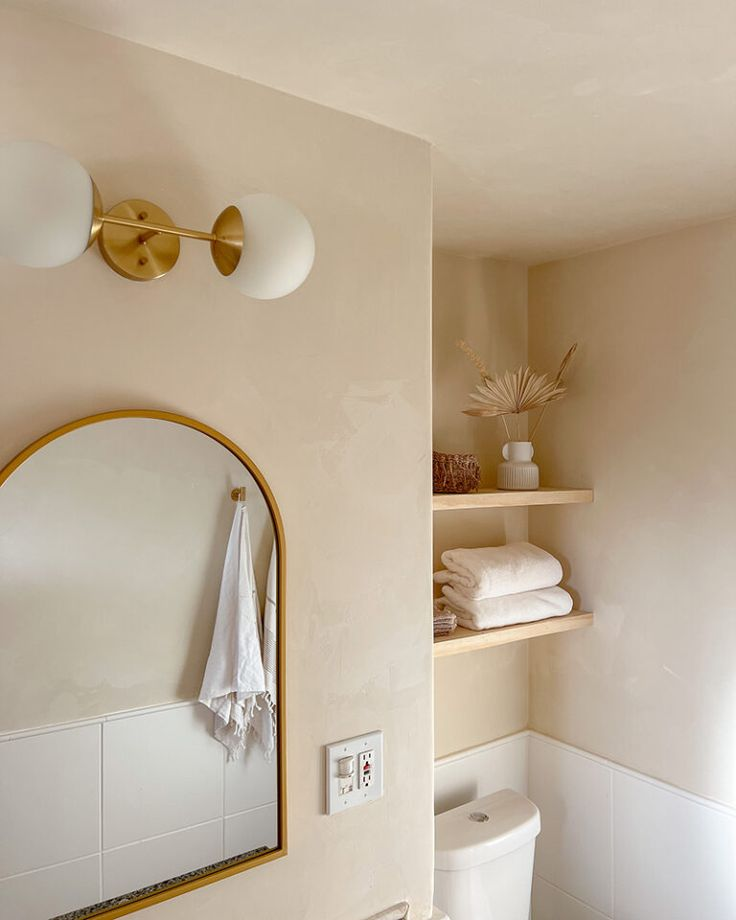
Tactile finishes can make a massive impact in bathrooms, and Roman clay offers a textured yet refined aesthetic. Its velvety matte appearance and nuanced depth mimic the look of traditional plaster without the heaviness of limewash. Applying Roman clay in terracotta tones introduces a cozy, sunbaked charm that pairs beautifully with ceramics and vintage brass accents. Unlike standard paint, this application brings movement and dimension, enhancing even a single wall. It resists moisture well when properly sealed, making it suitable for accent walls away from direct water contact. Terracotta Roman clay transitions wonderfully into other earthy palettes—think sandstone, clay pinks, or olive greens. The variation in tone adds authenticity and handcrafted appeal. This finish complements wood vanities, travertine tiles, and brushed bronze fixtures for a well-balanced composition. Ideal for creating a grounded yet elevated atmosphere, Roman clay proves that texture and tone can transform a utilitarian space into an artistic retreat.
Terracotta & Olive Green Pairing
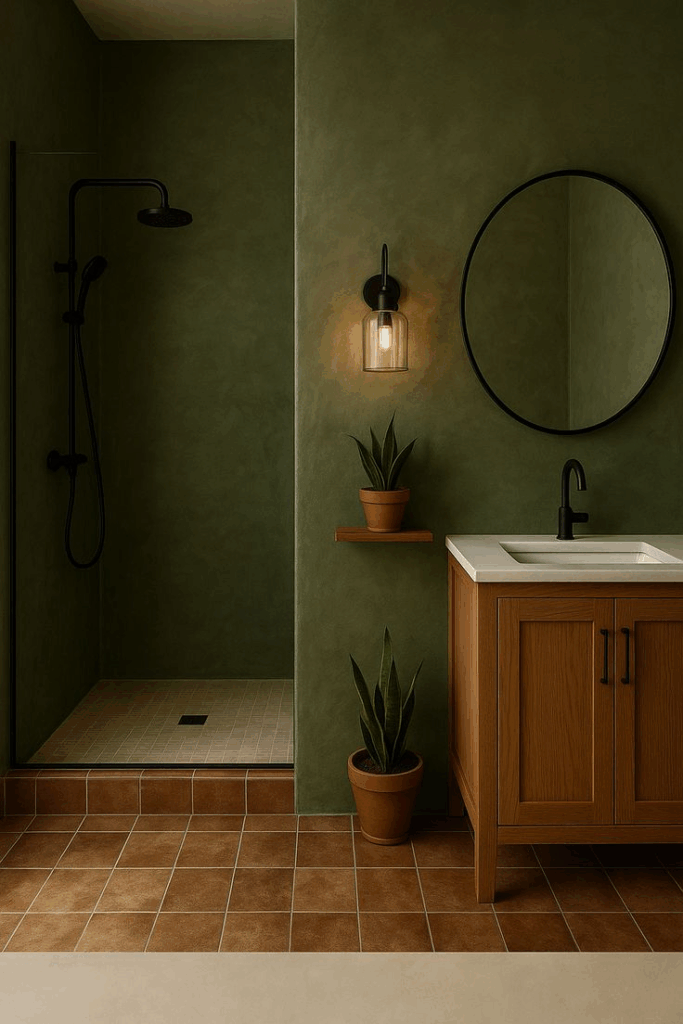
Color pairing plays a pivotal role in modern bathroom aesthetics, and terracotta combined with olive green strikes a rich, organic balance. This duo draws inspiration from natural landscapes—think clay soil and Mediterranean foliage—creating a grounded, earthy palette. Using terracotta on the walls, whether through tiles or paint, sets a warm base, while olive green cabinetry, textiles, or tiling introduces a calming contrast. The result is a mood that feels rooted, lush, and incredibly serene. Both hues work well with natural materials like rattan, teak, or stone, and they also accommodate finishes in brass, bronze, or black. This color scheme complements arched mirrors, botanical prints, and artisanal ceramics, reinforcing the grounded ambiance. Lighting plays an important role; warm white bulbs highlight the undertones of both shades without distorting them. This thoughtful palette choice caters to those seeking something more adventurous than neutrals but still sophisticated enough for long-term appeal.
Herringbone Terracotta Tile Layout
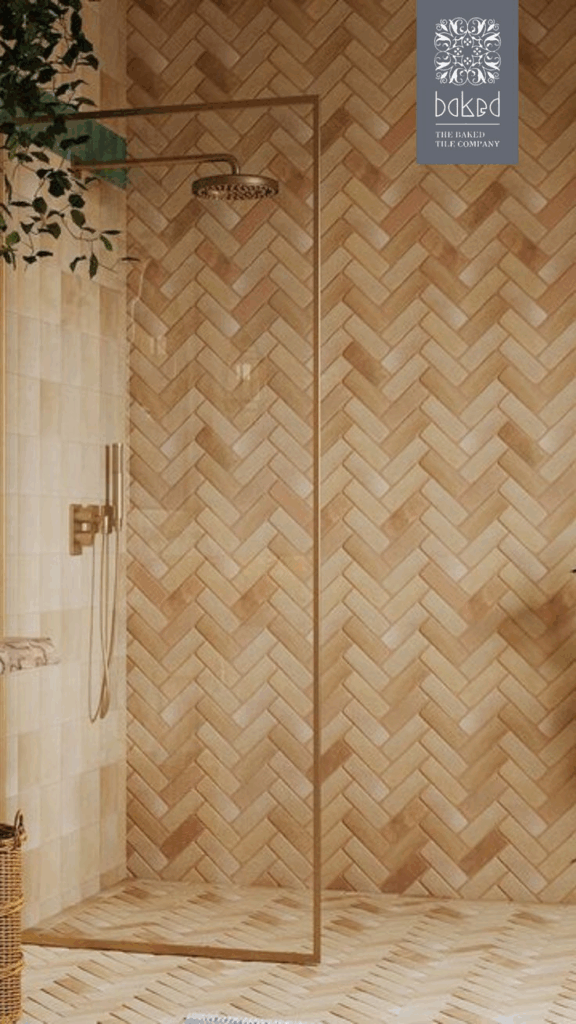
Patterned arrangements breathe life into traditional materials, and herringbone layouts using terracotta tiles offer just the right amount of visual rhythm. The angular repetition introduces movement and structure to any bathroom wall while retaining the handcrafted charm terracotta is known for. This layout works well as a backsplash behind vanities or along a feature wall behind freestanding tubs. Rectangular terracotta tiles laid in this timeless pattern draw the eye vertically or horizontally depending on orientation, helping elongate or widen the room as needed. Sealing the grout lines in a neutral tone ensures the warmth of the terracotta remains the focus, while a contrasting grout can add a touch of contemporary flair. Finishing the edges with brass trims or natural wood frames lends the space a curated, finished look. This approach is particularly well-suited for rustic, transitional, or Spanish Revival design schemes, where texture and layout carry equal visual weight.
Half-Wall Terracotta Paint
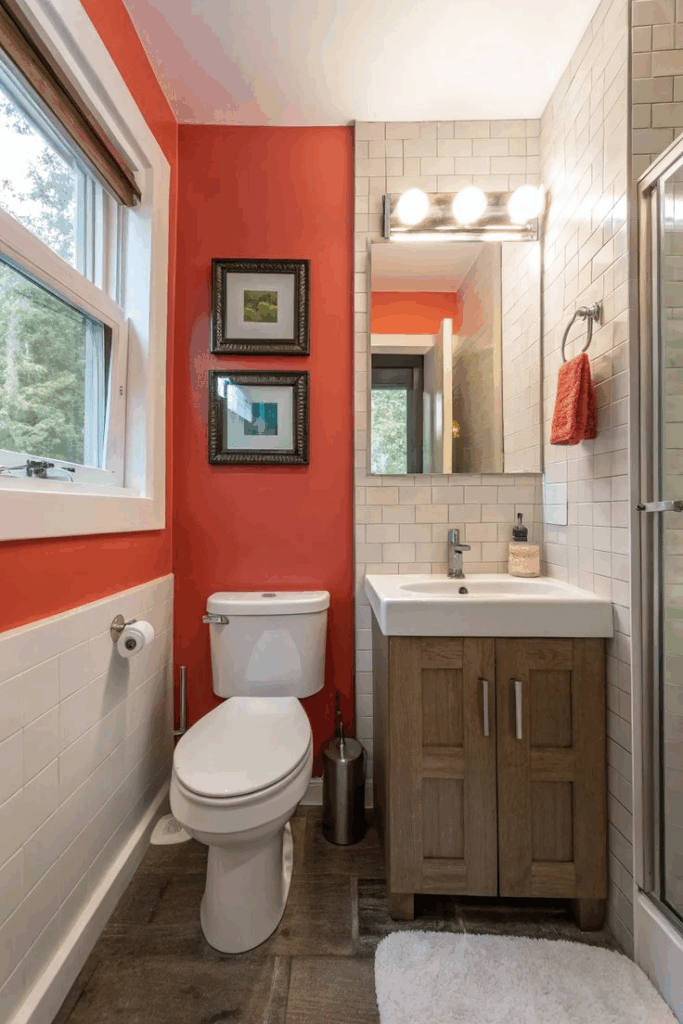
Layered design is key to balancing warmth and brightness, and half-wall terracotta paint delivers just that. By coating the lower half of bathroom walls in this grounded hue, it introduces warmth without overwhelming the space. The upper portion, often painted in off-white or ivory tones, ensures a light, open feel while allowing the earthy shade below to anchor the room. This method works exceptionally well in narrow bathrooms or powder rooms, where full-height dark walls might feel too enclosing. To enhance this two-tone effect, use a chair rail, bullnose trim, or simple color block transition. Pairing terracotta with textured wallpaper, ceramic tiles, or beadboard above introduces dimension while keeping the palette cohesive. Fixtures in matte black or antique brass can tie the look together beautifully. This paint style suits various design sensibilities—from farmhouse to eclectic—and provides an easy, budget-conscious way to embrace color and personality.
Terracotta & Brass Fixtures
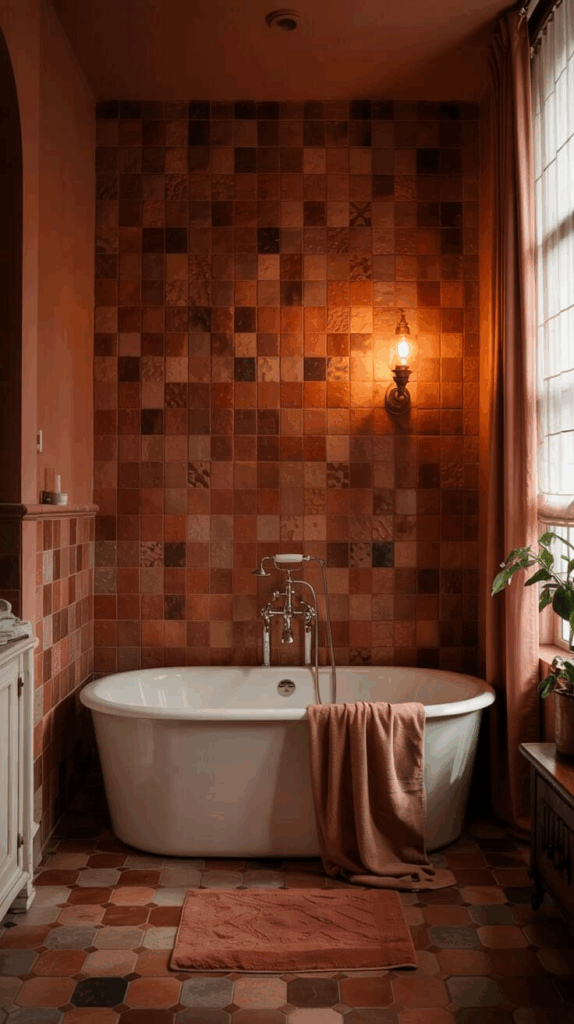
Few combinations feel as naturally luxurious as the pairing of terracotta tones with brass fixtures. The earthy warmth of terracotta acts as a soft backdrop, allowing the rich gleam of brass hardware to pop without feeling gaudy. This dynamic works especially well in bathrooms where understated elegance is the goal. Terracotta tiles—whether matte, glazed, or Roman clay—pair effortlessly with unlacquered brass faucets, sconces, and towel racks that develop a patina over time. The interplay between organic and opulent textures lends a sense of heritage and intention. To avoid visual clutter, keep the tile layout simple and let the metallic accents do the talking. This duo looks particularly refined when paired with marble countertops or wood vanities, striking a harmonious blend of modern and old-world appeal. Ideal for Mediterranean, boho luxe, or transitional bathrooms, this combination is both visually grounding and inherently elevated—designed to age gracefully while retaining timeless charm.
Textured Terracotta Plaster

Walls that invite touch add a deeper layer to bathroom design, and textured terracotta plaster does just that. Its softly rugged surface captures light and shadow in dynamic ways, enhancing even the smallest space with movement and richness. This finish feels artisanal, often applied by hand to achieve subtle ridges and swirls that make every installation one-of-a-kind. The terracotta tone reinforces the sense of warmth, anchoring the room with its sunbaked charm. When paired with smoother elements like polished concrete or glass, it creates an interplay of texture that feels curated and intentional. Proper sealing ensures moisture resistance, making it viable for walls outside the immediate splash zone. Accentuate with minimalist mirrors, open shelving, or matte black fixtures to avoid visual competition. For homeowners wanting something more tactile than paint but more understated than tile, textured plaster bridges the gap, offering depth without overwhelming the senses.
Terracotta Mosaic Niches
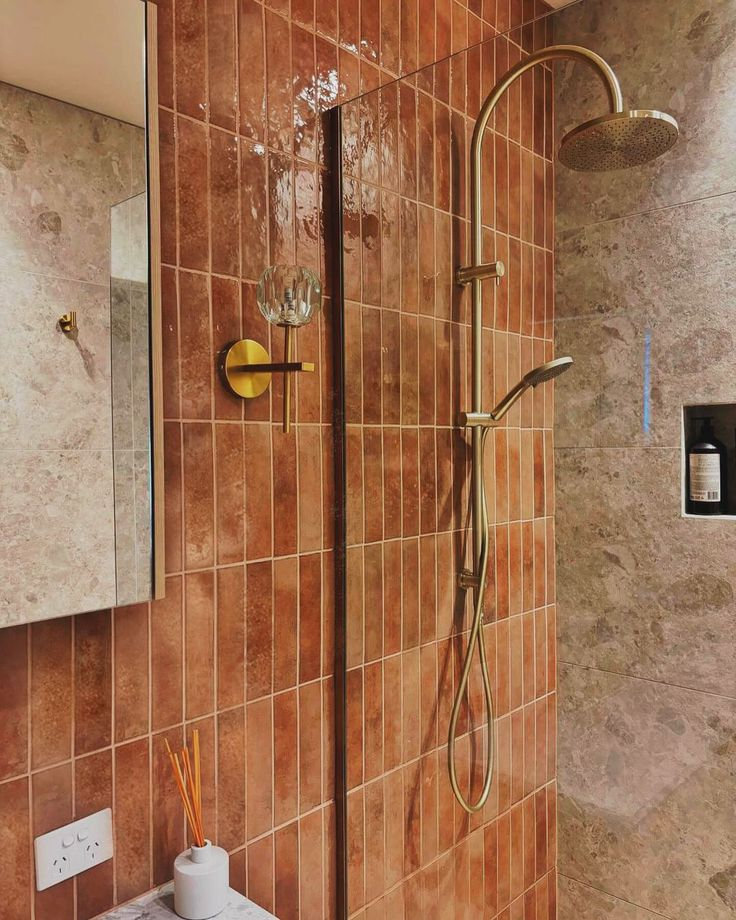
Functional details deserve just as much aesthetic attention, and mosaic-lined terracotta niches bring personality to utility. These recessed shelves, typically found in shower enclosures or beside tubs, become visual highlights when clad in warm, varied terracotta mosaics. The small-scale tiles introduce texture and movement, especially when arranged in Moroccan, hexagonal, or scalloped patterns. The richness of terracotta shades—from dusty rose to burnt sienna—adds depth and dimension. These niches not only store essentials but also serve as focal points within neutral or monochromatic bathrooms. Pair with bronze or brushed gold trim for added definition, or keep it rustic with unglazed edges and natural stone accents. When designing a niche, proportion matters—ensure enough space for toiletries while maintaining clean, geometric lines. This design idea is especially effective in bohemian, Spanish-style, or artisan-inspired bathrooms where even the smallest detail contributes to the overall ambiance and storytelling of the space.
Terracotta Zellige Tiles

Handcrafted aesthetics bring unmatched character, and terracotta Zellige tiles top the list for artisanal charm. These Moroccan tiles are known for their uneven edges, natural imperfections, and glossy glaze that bounces light throughout a space. Using them on a bathroom accent wall introduces richness and individuality—no two tiles are exactly alike. The result is a surface that feels alive, full of texture and depth. Ideal for backsplashes or vanity surrounds, Zellige tiles in warm terracotta hues create a sense of heritage while remaining thoroughly modern. The organic sheen works well with soft lighting, casting beautiful reflections that evolve throughout the day. Pair these tiles with lime-washed walls, brass fixtures, or rustic wood for a cohesive, globally inspired look. While installation requires a bit more precision, the final effect is well worth the effort. For homeowners seeking handcrafted elegance that stands out without shouting, Zellige tiles are a design-forward yet time-honored choice.
Terracotta & White Contrast
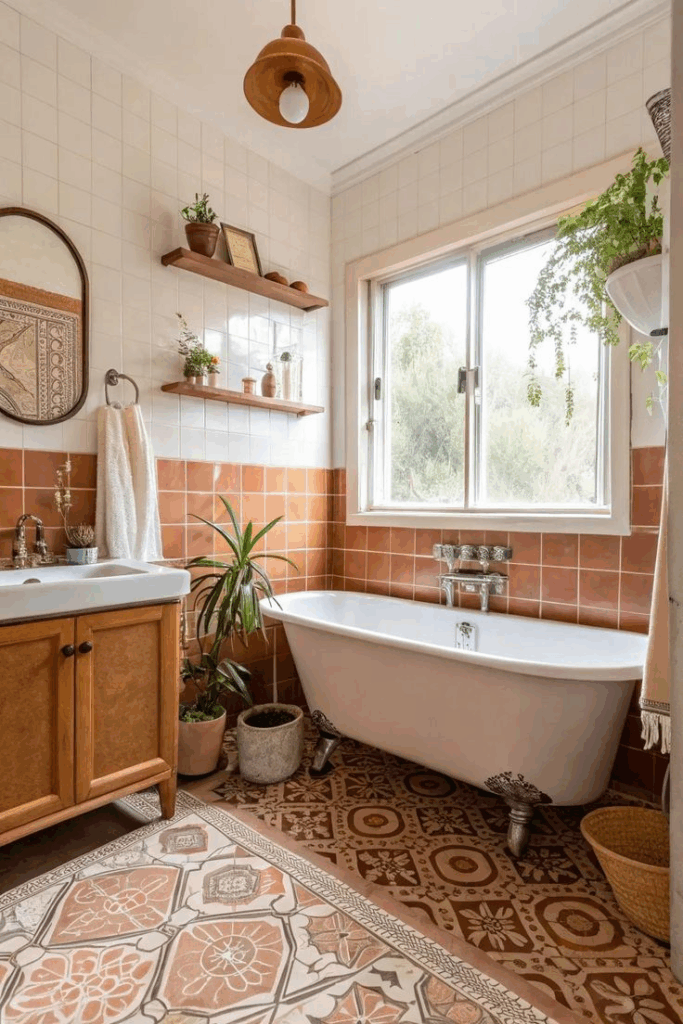
Visual contrast in bathroom design can establish clarity and calm, and terracotta paired with white achieves this effortlessly. This combination balances warmth with freshness, making the space feel grounded yet open. When terracotta is used on one feature wall or tiled section, white elements—like vanities, sinks, or upper walls—offer a clean visual break. The result feels Mediterranean-inspired but works just as well in contemporary or transitional bathrooms. Terracotta’s earthy tones soften the starkness of white, preventing the space from feeling too sterile. The palette thrives under natural light, with warm undertones glowing beautifully throughout the day. Opt for matte white finishes for a more cohesive flow, or incorporate white marble for a touch of luxury. This contrast can also be used to highlight architectural features—such as archways or alcoves—turning them into standout details. With just two well-chosen hues, this scheme creates an intentional, welcoming environment that never goes out of style.
Terracotta & Natural Wood Combo
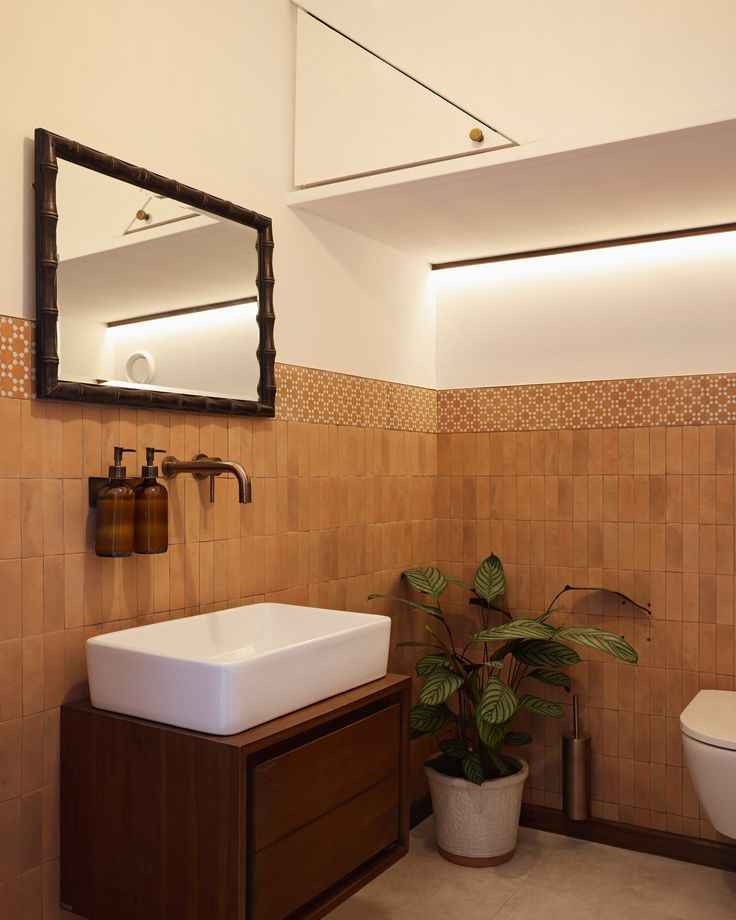
Natural materials have enduring appeal, and the pairing of terracotta with wood brings warmth and timeless character to bathroom interiors. The clay-rich tones of terracotta tiles or plaster complement the grain and texture of woods like oak, teak, or walnut. Whether used for wall accents, vanities, or open shelving, wood introduces softness and grounding. Terracotta’s warmth enhances wood’s golden undertones, creating a cohesive and organic palette that feels serene and lived-in. This combination works particularly well in Japandi, rustic-modern, or Mediterranean bathrooms where simplicity and texture take center stage. Keep the design balanced by varying textures—rough-sawn wood next to smooth terracotta tiles, for example. Brass or matte black hardware can elevate the look without overpowering it. By using natural finishes that age gracefully, this design approach ensures a bathroom that feels both stylish today and enduringly beautiful for years to come. The harmony between these materials is unmistakable and deeply comforting.
Terracotta Paneling with LED Accents

Ambient lighting meets tactile design in this innovative pairing, where terracotta wall paneling becomes the perfect canvas for integrated LED accents. Sculpted or grooved terracotta panels add depth to bathroom walls, while subtle lighting enhances their texture and shape. The warm clay hues naturally soften the glow of LEDs, producing a cozy, spa-like feel without the need for overwhelming brightness. Strategically placed LED strips—along vertical recesses or around mirror frames—bring modernity to a traditionally rustic material. This technique suits accent walls behind vanities or tubs where you want to spotlight design elements without hard wiring new fixtures. Choose dimmable lighting to adjust the mood, and complement the look with minimalist decor to let the textures and illumination shine. Terracotta paneling with backlighting not only increases visual interest but also provides functional, indirect lighting that enhances nighttime usability. This idea bridges handcrafted character with smart design innovation, adding flair and warmth in equal measure.
Terracotta & Black Fixtures
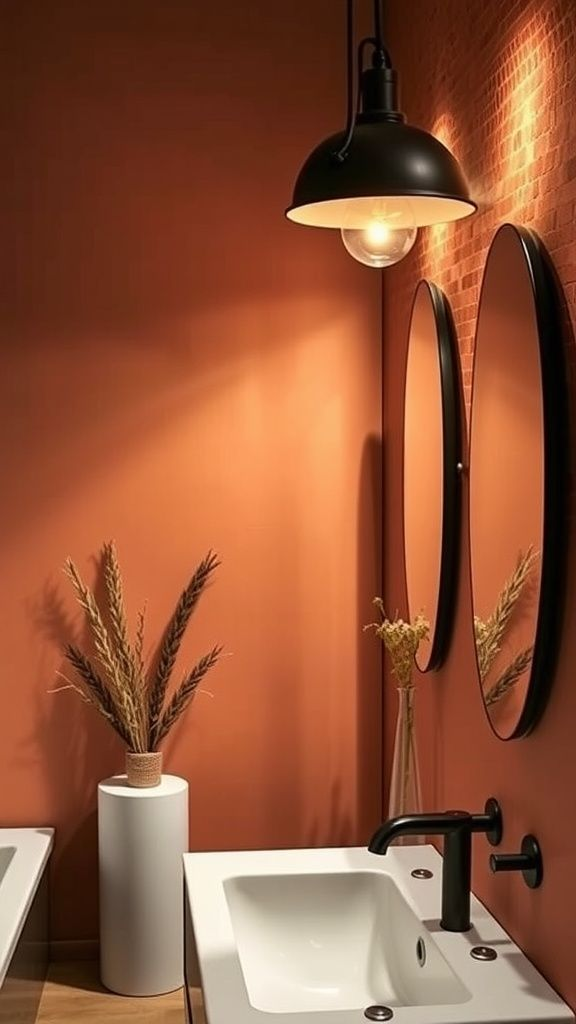
Earthy meets edgy when terracotta is paired with sleek black fixtures. The contrast between the sunbaked warmth of terracotta and the bold, matte finish of black hardware creates a modern yet grounded visual dynamic. This duo works beautifully in bathrooms aiming for a contemporary aesthetic with natural influences. Whether it’s a terracotta-tiled shower with a black rainfall head or clay-toned walls offset by angular black faucets, the effect is stylish and intentional. Black outlines add definition to terracotta surfaces, giving them a graphic, structured edge. To avoid the space feeling too stark, introduce textures—ribbed tiles, handmade ceramics, or brushed stone counters. Matte finishes on both elements keep reflections minimal, emphasizing form over flash. Wood accessories or soft textiles in cream and sand tones can bring warmth and balance. For those looking to introduce contrast without abandoning warmth, this pairing nails the brief with just the right balance of drama and earthiness.
Terracotta & Blush Pink Palette

Softness and depth come together in this unexpected yet visually rich combination. Terracotta brings warmth and earthiness, while blush pink introduces a light, romantic element that uplifts the overall aesthetic. The tonal harmony between these shades creates a visually cohesive palette that feels both modern and nostalgic. Use terracotta as the base tone through tiles or wall treatments, and introduce blush via towels, cabinetry, or painted upper walls. This color story thrives in bathrooms with natural light, where both shades can reveal their full spectrum of undertones. Accents in brass or rose gold blend effortlessly into the scheme, enhancing the gentle vibe. Marble or terrazzo surfaces with hints of pink can subtly echo the palette. Ideal for boho chic, mid-century, or soft contemporary interiors, this pairing offers a fresh alternative to traditional neutrals without veering too bold. It’s a look that’s serene, inviting, and undeniably charming—a breath of fresh air for any bathroom space.
Terracotta & Concrete Fusion
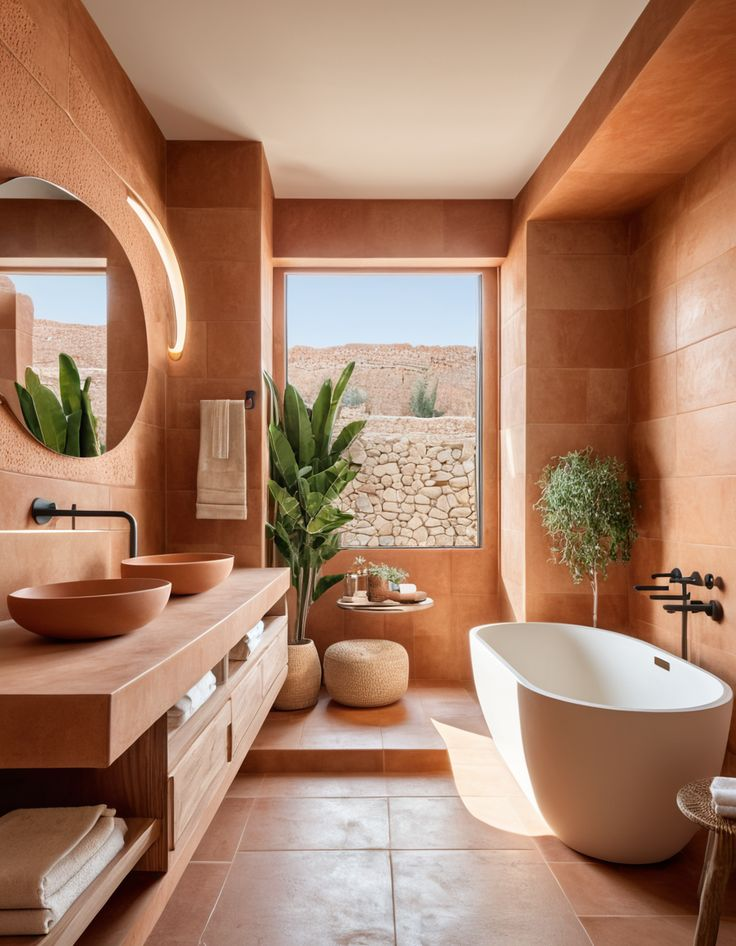
Raw meets refined in this material-driven concept that blends terracotta’s organic warmth with the cool industrial vibe of concrete. This fusion introduces a balanced juxtaposition—perfect for bathrooms seeking contrast in texture and tone. Terracotta tiles or walls add an earthy softness, while concrete vanities, sinks, or floors ground the space with structural clarity. The key is proportion and placement. Use terracotta as a vertical accent to warm up cooler elements below. Finishes in brushed metal or matte black can tie the materials together without clashing. When done well, this pairing feels architectural, restrained, and incredibly tactile. Opt for smooth concrete to contrast against textured terracotta surfaces, or vice versa, for dynamic layering. Wood shelves or woven baskets can soften the composition further. This palette suits industrial-modern, urban loft, or Scandinavian-inspired interiors that value simplicity with a tactile twist. The result is a bathroom that feels raw yet cultivated, bold yet completely livable.
